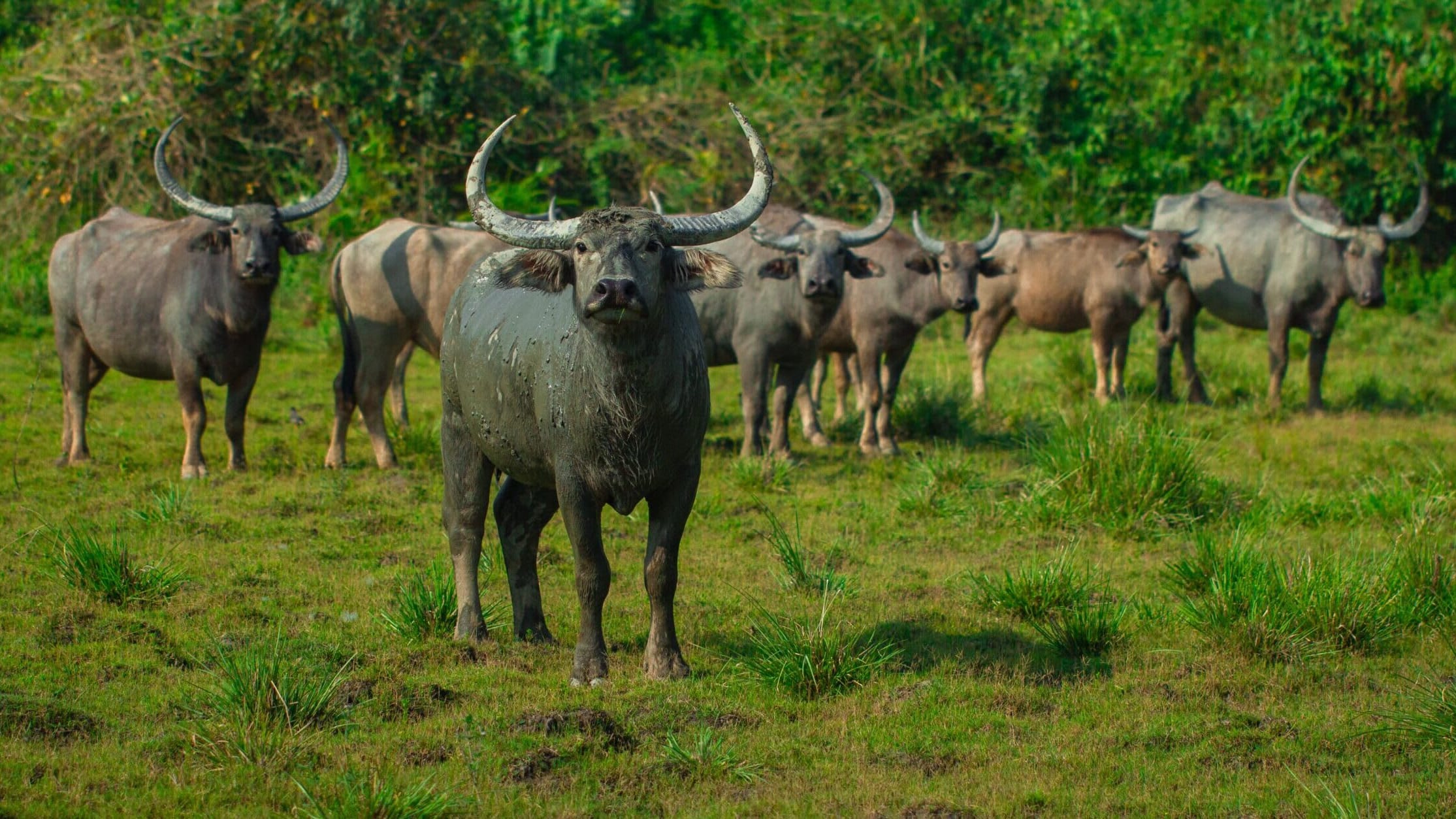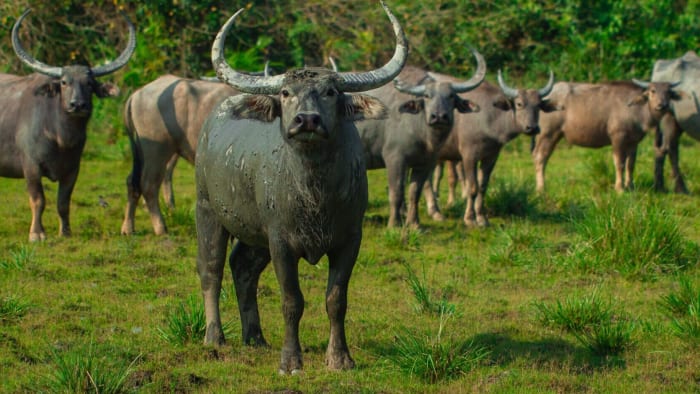 Listen to this article
•
15:34 min
Listen to this article
•
15:34 min
Chhattisgarh’s state animal, the wild water buffalo (Bubalus arnee), is facing global extinction, with fewer than 4000 individuals remaining in the wild. Approximately 90% of the existing population resides in India, primarily in two isolated clusters, in the northeast and central India. This makes the country a pivotal player in the revival of the species listed as endangered on the IUCN Red List.
A recent study delves into the potential of the species’ revival and provides a crucial strategy for reintroducing the wild water buffalo in Kanha Tiger Reserve, Madhya Pradesh. While the northeastern population of the animal remains robust, the central Indian population has dwindled to a mere 30-35 individuals. The once prominent population in Udanti-Sitanadi National Park, Chhattisgarh, now consists of only six bulls and no cows, raising significant concerns. In 2012, the Supreme Court of India urged Chhattisgarh to implement measures to revive the population, yet success in breeding the animal has remained elusive.
The study highlights Kanha as an ideal reintroduction site after evaluating the habitat suitability and carrying capacity, considering the global distribution of buffalo populations. Kanha’s 390 sq. km. of low-lying grasslands, with minimal human disturbance, emerged as a suitable habitat for the species. The reintroduction strategy includes identifying 200 wild water buffaloes from the source population in northeast India which are found to be genetically similar to the central Indian buffaloes and releasing them in batches of 15-20 at a time at the designated habitats.

Cover photo: Wild water buffaloes at Kaziranga National Park, Assam. The central Indian population of the species is critically endangered with less 35 individuals remaining in the wild. Photo: Naitik Patel
Reintroduction of buffaloes as a nature-based solution to grassland degradation
Researchers identify numerous benefits in reintroducing this mega herbivore to the wilderness of Central India, including its innate ability to maintain ecological balance within open grass ecosystems. According to the lead author of the study, Jayant K. Bora of the Wildlife Institute of India, Kanha’s ecosystem is primarily dominated by small ungulates, which are selective feeders due to their small snouts. Conversely, mega herbivores like wild water buffaloes graze on a variety of plants, contributing to the succession mechanism, wherein each species in a habitat has an equal chance of being consumed (and regenerated) by an animal. Bora says, “Since the wild water buffaloes were removed from the region, this ecological niche has remained vacant. If we reintroduce this species, it will fill the void.”
Bora notes that most natural grasslands in the country, especially in lowland areas, have been lost primarily due to land use changes. Considering that the grasslands in Kanha are human-created ecosystems, mostly established on sites vacated by villages since the Project Tiger initiative in the 1970s, these grasses tend to evolve into woodlands due to the presence of surrounding forests and natural succession mechanisms. “We envision that the presence of buffaloes could control weeds and shrubs, thereby maintaining the grassland ecosystem,” says Bora. Historical hunting records indicating the presence of the animal in these areas have further strengthened the researchers’ conviction that reintroduction would be successful and beneficial for Kanha’s grasslands.
Ninad Mungi, also of the Wildlife Institute of India and a co-author of the study, highlights the historical evolution of grassland ecosystems globally, emphasising the crucial roles of two key regulators — fire and mega herbivores. Certain grasses have developed defence mechanisms against these regulators over time. The absence of either or both regulators can result in grasses with stronger defence systems dominating the ecosystem, necessitating intense human management to maintain ecological balance.
Ensuring genetic purity and managing predator pressure
The decline in the wild buffalo population is primarily attributed to various factors, as outlined in the paper, including historical domestication (river and swamp buffaloes or Bubalus bubalis are the domesticated species), habitat loss of grassy and swampy ecosystems, disease transmission and competition from livestock. Additionally, historical hunting as a sporting activity by colonial rulers resulted in large-scale decimation of the species. The paper highlights the slow life history traits of the species, such as long gestation periods, inter-birth intervals, and late onset of reproduction, which have hindered rapid population recovery after threats were mitigated. Bora mentions the concept of “extinction debt,” referring to the future extinction risk of the species due to past events it has endured.
Furthermore, the location of a majority of the surviving central Indian population presents a conservation challenge, as it is situated in the heartland of the Naxalite-Maoist insurgency. This complicates conservation efforts, scientific monitoring, and law enforcement, making conservation investments particularly challenging.

As researchers advocate for introducing members of the northeastern population as the most viable solution, Anwaruddin Choudhury, a naturalist and expert in the wild fauna of the northeast, raises concerns regarding genetic distinction between the two species, habitat disparities, and predator presence. While he supports the idea of reintroduction, Choudhury believes that there aren’t sufficient evidence to establish the genetic similarity between the two species. He suggests, “Instead of intermixing the species, it would be preferable to relocate individuals from species-abundant areas in central India to Kanha.”
In contrast, Mungi asserts that genetic studies conducted by the researchers demonstrate that the two species, though isolated, are not genetically distinct. Additionally, he argues that removing individuals from the already depleted Chhattisgarh population would further endanger it.
Choudhury suggests that northeastern buffaloes would have a better chance of survival in Dudhwa National Park in Uttar Pradesh, citing its marshy grasslands similar to those of Kaziranga or Manas National Parks in Assam. He raises concerns about the dry grasslands of Kanha, which may not be optimal for buffaloes from the northeast. Choudhury also expresses apprehension regarding the high tiger density in Kanha, which could pose a threat to the reintroduction effort.
As a proposed solution, the study suggests fencing the selected buffalo population within a predator-proof enclosure containing 1-5 sq km of natural habitat. “Once the founders breed within this fenced area, they would be released as free-ranging individuals in large social units of more than 15-20 individuals at any one time, while maintaining a breeding population within the fenced area,” the study explains.
While the hurdles remain unknown, the expectation is that reintroducing wild buffaloes could potentially act as a nature-based solution for multiple global ecological challenges while preventing the extinction of a mega herbivore that plays a pivotal ecological role in grassland ecosystems.
This story was first published on Mongabay India






